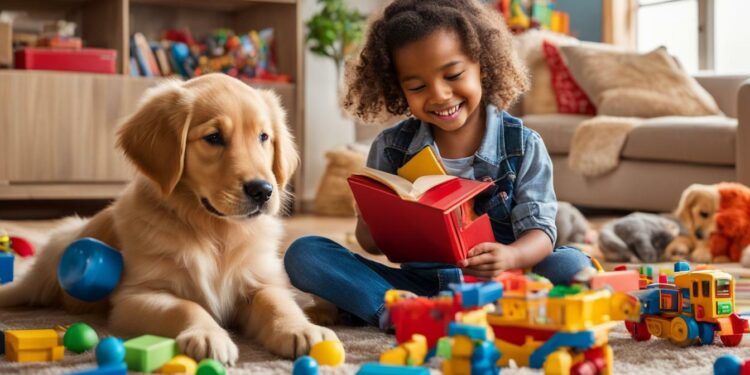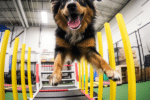Why You Should Adopt a First Puppy in the Home with Kids

If you’re considering getting a pet for your family, a puppy could be an excellent choice, especially if you have children. Adopting your first puppy can be a rewarding and exciting experience, not only for the kids but for the entire family. Here are some reasons why you should consider adopting a first puppy. Adopt Puppy
- Adopting a first puppy can teach children responsibility and empathy.
- A puppy can provide various health benefits for children, including physical activity and emotional support.
- Having a puppy can strengthen the bond between children and their families, creating cherished memories and companionship.
Key Takeaways:
- Adopting a puppy can be a rewarding experience for families with children.
- A puppy can teach children valuable life skills, such as responsibility and empathy.
- Having a puppy can provide various health and emotional benefits for children.
Considerations for Getting a Puppy for the First Time
Getting a puppy for the first time can be an exciting and rewarding experience for you and your family. However, before bringing your new furry friend home, there are several important factors to consider.
Preparation is key when it comes to getting a puppy. You’ll need to ensure that your home is a safe and comfortable environment for your new pet. This includes puppy-proofing your house by removing any hazardous items and securing electrical cords and loose objects.
Another essential consideration is purchasing the necessary items for your new puppy. This includes a comfortable bed, food and water dishes, quality puppy food, toys, and grooming supplies. It’s also important to schedule a visit with a veterinarian to ensure that your puppy is healthy and up-to-date on all necessary vaccinations.
When choosing a puppy, it’s important to select a breed that is well-suited for first-time owners. Consider factors such as energy level, temperament, and size, and choose a breed that fits your lifestyle and living situation. There are several breeds that are known for being great with children, including Golden Retrievers, Labradors, and Beagles.
Overall, preparation is essential when it comes to getting a puppy for the first time. By taking the time to puppy-proof your home, purchase necessary supplies, and choose the right breed, you can ensure a smooth and enjoyable experience for both you and your new furry friend.
Choosing the Best Breed for First Time Owners
When it comes to adopting a puppy as a first-time owner, choosing the right breed is crucial for ensuring a successful and enjoyable experience for both you and your furry friend. Some breeds are naturally more suited to families with children, while others may require more attention and training.
One of the top breeds recommended for first-time owners is the Golden Retriever. Not only are they friendly and easy to train, but they also have a reputation for being excellent with children. Similarly, Labrador Retrievers are popular for their loyal and friendly temperament, and they are also known for their love of playtime.
If you’re looking for a smaller breed, the Cavalier King Charles Spaniel is a great option. These dogs are known for being affectionate and adaptable, and they don’t require as much exercise as some larger breeds. Additionally, Beagles are a popular choice for families with children, as they are good-natured and love to play.
It’s important to research each breed thoroughly before making a decision. Consider the breed’s energy level, exercise needs, and temperament, and how they will fit into your family’s lifestyle. By doing your research and choosing the right breed, you can ensure a happy and healthy life for your new puppy.
Understanding the Puppy Adoption Process
Adopting a puppy can be an exciting and fulfilling experience for families with children. However, it is important to understand the puppy adoption process before bringing your new furry friend home. Here are some tips for adopting a puppy:
- Research and choose a reputable shelter or breeder: Do your research and find a reputable shelter or breeder in your area. Ask for references or reviews from previous customers and make sure they prioritize the welfare of their animals.
- Consider your lifestyle and preferences: It is important to choose a breed that suits your lifestyle and preferences. Consider factors such as size, energy level, and temperament to find the perfect match for your family.
- Prepare your home: Make sure your home is prepared for your new puppy’s arrival. This includes purchasing essential supplies such as food, water bowls, and a crate, as well as puppy-proofing areas of your home where your puppy will spend time.
- Complete the adoption process: The adoption process may vary depending on where you adopt your puppy from, but typically involves filling out an application, meeting the puppy, and paying an adoption fee.
- Provide proper care and training: Once you bring your puppy home, it is important to provide proper care and training to ensure their health and happiness. This includes regular veterinary check-ups, socialization with other dogs and people, and obedience training.
Adopting a puppy can be a rewarding experience, but it is important to approach the process with patience and care. By following these tips and being prepared, you can ensure a smooth transition for both your family and your new furry friend.
Puppy Adoption Checklist
If you’re preparing to bring home your first puppy, it’s essential to have everything in order to ensure a smooth transition for both your family and your furry friend. Here is a comprehensive puppy adoption checklist to help you get started:
Before bringing your new puppy home:
- Research and choose a breed that is suitable for your family and lifestyle
- Purchase a crate that is big enough for your puppy to stand up, turn around, and lie down comfortably
- Buy a leash and collar
- Get a food and water bowl
- Pick out a high-quality dog food that meets your puppy’s nutritional needs
- Stock up on puppy pads for potty training
- Get a soft and comfortable bed for your puppy to sleep in
- Choose safe and appropriate toys for your puppy to play with
- Make sure you have a veterinarian lined up and schedule a first check-up
On the day of arrival:
- Ensure your home is safe for your new puppy by removing any hazardous items or objects
- Show your puppy where their bed, food, and water are located
- Introduce your puppy to their crate and encourage them to explore it
- Take your puppy outside frequently for potty breaks and positive reinforcement
- Introduce your puppy to family members slowly and calmly
By following this checklist, you’ll be well-prepared to welcome your new puppy into your home and begin a wonderful lifelong journey together.
Preparing Your Home for a New Puppy
Bringing home a new puppy is an exciting time for any family, but it’s important to make sure your home is ready for the new addition. Here are some essential items you’ll need to have on hand:
| Item | Quantity |
|---|---|
| Puppy food | 2-3 weeks supply |
| Water and food bowls | 2 each |
| Collar and leash | 1 each |
| Training pads | 20-30 |
| Bed | 1 |
| Crate | 1 |
| Chew toys | Several |
| Grooming supplies | Brush, shampoo, nail clippers |
It’s important to have a designated sleeping area for your puppy, whether it’s a crate or a comfy bed. This not only helps with house-training, but also provides a sense of security for your new pup.
Make sure to also puppy-proof your home by removing any potentially hazardous items and keeping electrical cords and small objects out of reach. Secure any cabinets or doors that your puppy shouldn’t have access to.
Finally, establish a routine for your new puppy. This includes regular feeding times, potty breaks, and playtime. Consistency will help your puppy adjust to their new home and feel more comfortable.
Introducing Your New Puppy to Kids
Adopting your first puppy is an exciting time for your family, especially for your children. It’s important to remember, however, that the introduction between your new puppy and your children should be handled with care. Preparing for a new puppy means preparing your children as well.
Firstly, it’s important to teach your children how to approach and handle a puppy safely. Encourage gentle petting and discourage rough play. Show them how to hold a puppy correctly, supporting its body and neck at all times.
To ensure a smooth introduction, it’s a good idea to have your children supervise while an adult handles the puppy initially. This allows the puppy to get comfortable with its surroundings and reduces the risk of accidental injuries.
Additionally, it’s important to establish boundaries for both the puppy and your children. Teach your children that the puppy needs rest and alone time, and should not be disturbed while sleeping or eating. This helps avoid conflicts and ensures a respectful and harmonious relationship between your children and their new furry friend.
Preparing for a new puppy can be overwhelming, but with proper planning and guidance, introducing your new puppy to your children can be a joyous and exciting experience for everyone.
The Joy of Having a Puppy in the Home
As a professional copywriting journalist, I have witnessed firsthand the joy and happiness that a puppy can bring into a home with children. Adopting a first puppy is a wonderful experience that can positively impact the entire family, creating long-lasting memories and companionship.
The puppy adoption process can be a bit overwhelming for first-time owners, but the benefits far outweigh any challenges. When you adopt a first puppy, you are giving your children the opportunity to learn responsibility, empathy, and compassion for animals. Plus, the health and emotional benefits of owning a puppy are numerous and well-documented.
Of course, raising a first puppy comes with its own set of challenges. Puppies require a lot of attention, training, and patience. However, with the right preparation and mindset, these challenges can be overcome.
Adopting a first puppy is an exciting and rewarding experience that can bring a lot of joy and happiness into a home with children.
Developing Responsibility and Empathy in Children
Adopting a first puppy is not just about adding a new member to the family; it can also be an educational opportunity for children. Raising a puppy requires a level of responsibility that can teach children important life skills. From feeding and grooming to training and playtime, kids can learn how to care for another living being. This responsibility also teaches them the importance of accountability and reliability, skills that are transferable to future endeavors.
In addition to responsibility, adopting a first puppy can also teach children empathy. Caring for a puppy requires an understanding of their needs and emotions. As children learn to recognize the different ways their puppy communicates with them, they develop empathy and compassion for others. This skill extends beyond the puppy to other humans, animals, and even the environment around them.
Having a first puppy can be a valuable tool for parents to instill responsibility and empathy in their children.
Creating a Positive Learning Experience
As with any learning opportunity, it’s essential to create a positive experience for children. Encourage them to take an active role in caring for their puppy, whether it’s through feeding, grooming, or training. Use positive reinforcement to encourage good behavior and discourage negative behavior. This approach not only strengthens the bond between the puppy and the child but also reinforces the importance of positive communication and kindness in all relationships.
As children learn to care for a puppy, show them the importance of patience and perseverance. Raising a puppy can be challenging at times, but these moments provide valuable lessons for children. Encourage them to stick with it, even when it gets tough. This mindset will help them develop grit and determination, skills that are necessary for success in all areas of life.
By creating a positive learning experience, parents can help their children develop responsibility, empathy, and valuable life skills through adopting a first puppy.
Health and Emotional Benefits of Owning a Puppy
Adopting a first puppy is not only a fun and exciting experience, but it also has numerous health and emotional benefits for both children and adults. Studies have shown that owning a pet can reduce stress, anxiety, and depression, as well as lower blood pressure and strengthen the immune system.
Furthermore, having a puppy in the home can encourage physical activity, as children will have a new playmate to run and play with. This can lead to improved cardiovascular health, stronger bones and muscles, and a reduced risk of obesity.
Additionally, owning a puppy can have a positive impact on a child’s emotional development. It can help them develop a sense of responsibility and empathy, as they learn to care for and nurture their new furry friend. This can also lead to improved social skills, as children learn to communicate and interact with their pet.
When choosing the perfect first puppy, it’s important to consider the specific needs and personalities of both the dog and your family. Some breeds are known to be more energetic and playful, while others may be more laid back and affectionate. By finding a puppy that fits well with your family’s lifestyle and personality, you can ensure a happy and healthy relationship for years to come.
Overall, adopting a first puppy is not only a joyful experience, but it can also have numerous health and emotional benefits for both children and adults. By finding the perfect puppy for your family and providing a loving and nurturing home, you can enjoy the companionship and happiness that comes with having a furry friend by your side.
Nurturing the Bond Between Kids and Their First Puppy
One of the greatest joys of having a first puppy in the home is the special bond that forms between children and their new furry friend. The bond between a child and their first puppy is unlike any other, filled with unconditional love, playful energy, and endless adventures.
When searching for the perfect first puppy for your family, consider factors such as size, temperament, and energy level. It’s important to choose a breed that is well-suited for families with children, as this can help ensure a positive and fulfilling experience for everyone involved.
Once you’ve found the right puppy, it’s time to start building that special bond. Encourage your child to spend time with their new friend, playing, cuddling, and bonding over shared experiences. As your puppy grows, so will the bond between them and your child.
This bond can teach children valuable life lessons about love, responsibility, and empathy. It can also create lasting memories and provide a source of comfort and companionship throughout their childhood and beyond.
Remember, the bond between a child and their first puppy requires time, patience, and effort to nurture and strengthen. But with dedication and love, it can become one of the most rewarding relationships in a child’s life.
Overcoming Challenges in Raising a First Puppy
Getting a puppy for the first time can be an exciting experience for the whole family. However, it can also present a number of challenges that you need to be prepared for.
One of the biggest challenges is managing your puppy’s behavior. Puppies can be very energetic and curious, which can sometimes lead to destructive or even dangerous behavior. To overcome this challenge, it’s important to establish clear rules and routines from the beginning. For example, you can teach your puppy which areas of the house are off-limits, and provide appropriate toys and activities to keep them occupied and happy.
Another challenge is potty training. This can be a time-consuming process, but it’s important to be patient and consistent. Establish a routine for taking your puppy outside to go potty, and reward them with plenty of praise and treats when they succeed.
Additionally, taking care of a puppy requires a significant time commitment. This can be especially challenging if you have a busy schedule or young children to care for. To overcome this challenge, consider hiring a dog walker or pet sitter to help with your puppy’s care when you’re not available.
Finally, it’s important to be prepared for the unexpected. Puppies can get sick or injured, which can be stressful and costly. Make sure you have a plan in place for emergency vet care, and consider investing in pet insurance to help cover unexpected expenses.
Overall, raising a first puppy can be a rewarding and joyful experience for you and your family. By understanding and preparing for the challenges that may arise, you can ensure a smooth and successful transition for your new furry friend.
Conclusion
In conclusion, adopting a first puppy for families with children can bring countless benefits, including joy, companionship, and valuable life lessons. By preparing for the puppy’s arrival, choosing the right breed, and introducing the puppy to your children safely, you can ensure a smooth transition and establish a strong bond. While there may be challenges in raising a puppy, the rewards are well worth the effort. So, if you’re ready to embrace the joys of pet ownership, I encourage you to consider adopting your first puppy and experience the unconditional love and loyalty that only a furry friend can provide. Remember, adopt first puppy and watch your family blossom with love and happiness.
FAQ
Q: What are the benefits of adopting a puppy as a first pet for families with children?
A: Adopting a puppy as a first pet for families with children has several benefits. Puppies can teach children about responsibility and empathy, and they can also bring joy and happiness into the home. Additionally, having a puppy can have various health and emotional benefits for both children and adults.
Q: What factors should I consider before getting a puppy for the first time?
A: Before getting a puppy for the first time, it is important to consider factors such as preparation, essential items, and the adoption process. It’s crucial to prepare your home for the puppy’s arrival and make it safe and comfortable. You should also familiarize yourself with the puppy adoption process and make a checklist of all the necessary items you will need.
Q: How do I choose the best breed for first-time owners?
A: Choosing the best breed for first-time owners depends on various factors such as lifestyle, living space, and family dynamics. It is important to research different dog breeds and find one that is well-suited for first-time owners and families with children. Consider factors such as size, energy level, and temperament when choosing the best breed for your family.
Q: What is the puppy adoption process like?
A: The puppy adoption process typically involves researching local shelters or breeders, filling out an adoption application, and going through an interview and screening process. Once approved, you will need to pay an adoption fee and complete any required paperwork. It’s important to be prepared for the process and have patience during the waiting period.
Q: What should be on my puppy adoption checklist?
A: Your puppy adoption checklist should include items such as food and water bowls, a leash and collar, bedding, toys, grooming supplies, and puppy-proofing items for your home. It is also important to schedule a visit to the veterinarian for vaccinations and to discuss any necessary puppy care.
Q: How can I prepare my home for a new puppy?
A: To prepare your home for a new puppy, you should puppy-proof your living space by removing any potentially dangerous items or substances. Set up a designated area for the puppy with a bed, toys, and access to food and water. It’s also important to establish a routine and familiarize yourself with housetraining techniques.
Q: How can I introduce my new puppy to my kids?
A: When introducing your new puppy to your kids, it’s important to do so in a calm and controlled environment. Teach your children how to approach the puppy gently and let them spend supervised time together. Encourage positive interactions and teach your children how to properly handle and care for the puppy.
Q: What are the emotional benefits of owning a puppy?
A: Owning a puppy can bring various emotional benefits such as increased happiness, reduced stress, and improved overall well-being. Puppies can provide companionship and unconditional love, and they can also help children develop empathy and social skills.
Q: How can I overcome challenges in raising a first puppy?
A: Raising a first puppy can come with challenges, but with the right approach, they can be overcome. It’s important to be patient and consistent with training, establish a routine, and seek guidance from experienced dog owners or professionals. Remember to give yourself and your puppy time to adjust and grow together.






